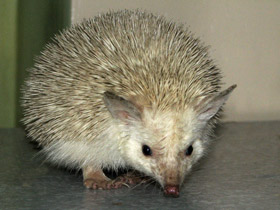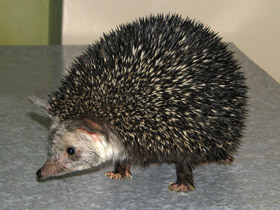Brandt's hedgehog (Paraechinus hypomelas)
Brandt's hedgehog (Paraechinus hypomelas) is a species of desert hedgehog native to parts of the Middle East and Central Asia. Its common name derives from its having first been described by Johann Friedrich von Brandt, a director of the Zoological Department at the St Petersburg Academy of Sciences.
Appearance
Paraechinus hypomelas is a species of erinaceomorph mammal of the family Erinaceidae.
Paraechinus hypomelas is a large hedgehog with a long, smooth coat, reaching a body length of 23-27 cm and weighing 500-900 g. Its needles are thick and long (40-42 mm), it has a distinct patch of bare skin ("bald") at the apex; the spiny carapace of its head is divided by a broad "stripe". The lower body of Paraechinus hypomelas is covered with soft, long hairs; the ears are soft, coloured grey inside and longer than half of the head; its snout is black-brown with some white hairs on the forehead.
Interestingly, the species has two colour forms: light and dark. Sometimes both dark and light-coloured hedgehogs are born from the same female. Light-coloured hedgehogs have pure white undersides, heads and ears. The needles are also white, without transverse stripes.
Dark hedgehogs are characterised by black spots, which predominate on the limbs and flanks of the animal. Dark hedgehogs have a black pattern on the forehead, cheeks and sometimes on the abdomen; their spiny carapace is also blackish.
Habitat and behaviour
Paraechinus hypomelas is distributed along the eastern coast of the Caspian Sea and south from Central Asia to the Pamirs, and can be found in Iran, Pakistan, Afghanistan, Oman, Yemen, the Persian Gulf islands, southern Arabia and the UAE. In the mountains, Paraechinus hypomelas can be found up to 1400m. It is an inhabitant of clay and sandy deserts and lives in both plains and foothills.
This animal runs much faster than other hedgehogs; when disturbed it emits a high-pitched squeal. Paraechinus hypomelas digs burrows up to 1 m deep with several exits, or nests in the burrows of large sandflies. An individual may have 5-7 burrows or small shelters in cliffs or rock piles.
It is active at dusk and at night. Their activity depends on weather conditions. When it rains, hedgehogs are only active during the first half of the night, but may come out during the day.
During the dry season, they are active from dusk to dawn. While hunting, the hedgehog can move up to 600-800 metres away from the nearest shelters.
In the northern part of the range, Paraechinus hypomelas hibernates during winter. In autumn, they put on weight, but their fat mass does not exceed 14% of their body weight. When the ambient temperature drops to 14-16°C, the animal stops coming out of hiding, and at a temperature of 10°C begins to prepare for hibernation. Paraechinus hypomelas closes the entrance to the burrow from the inside before falling asleep.
Nutrition
Paraechinus hypomelas feeds mainly on insects. The main part of its diet consists of large beetles (especially black flies), locusts, cicadas, beetles, click beetles and weevils. A hedgehog eats up to 110 different invertebrates a day. It may also feed on small reptiles (including snakes) and rodents.
Reproduction
The breeding season of Paraechinus hypomelas is from March to June. After 36 days of gestation, the female gives birth to one to six (more often three to four) naked and blind young. By this time, she has built a special nest for the young.
The same female can give birth to dark and light coloured hedgehogs.
The body of the newborns is flattened, 3.5 to 4 cm long, smoky or pinkish in colour, with closed eyes and ear holes, bare abdomen and small tubercles in closely spaced rows on the back. The soft white tips of the future needles protrude from the tubercles by 1.5 mm. Until 2-3 weeks of age, the young are fed on mother's milk and are completely defenceless.
The young grow very rapidly (according to observations in captivity, their mass multiplies by 11.3 times in 18 days). When the paraechinus hypomelas grow a little, they start to leave the shelter and, in addition to their mother's milk, try to eat solid food. At 1-1.5 months of age, young hedgehogs leave their mother's den and begin to live an independent life.
Subspecies
There are multiple subspecies of Brandt's hedgehog:
- Paraechinus hypomelas blanfordi;
- Paraechinus hypomelas hypomelas;
- Paraechinus hypomelas niger;
- Paraechinus hypomelas seniculus.

















































